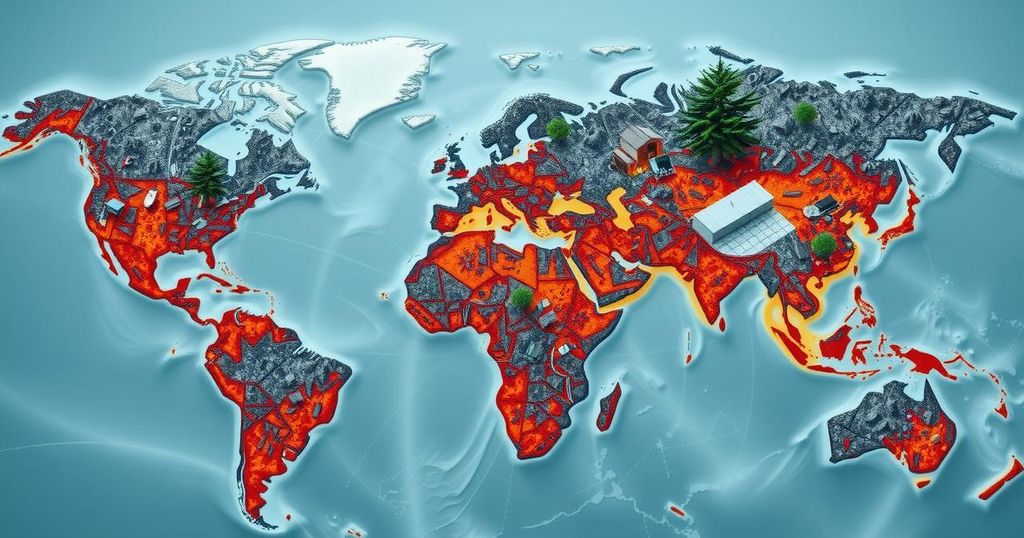Natural Disasters in 2024: A Year Marked by Catastrophe and Climate Crisis
In 2024, natural disasters resulted in hundreds of deaths and billions in damages globally. Severe weather events, including hurricanes, floods, and earthquakes, impacted regions in the United States, Southeast Asia, South America, and more. The year marked unprecedented heat, with climate change driving higher frequencies of catastrophic events, all highlighting the urgent need for improved disaster response strategies.
In 2024, devastating natural disasters were responsible for the deaths of hundreds and the incurrence of billions in damages worldwide, according to reports. A series of storms, earthquakes, and extreme weather phenomena wreaked havoc in various regions. Noteworthy incidents included a catastrophic series of tornadoes in the United States, substantial flooding in Afghanistan, catastrophic events in Papua New Guinea, and significant typhoons in Southeast Asia, displaying an alarming trend in climate-induced catastrophes.
The year set a record for extreme temperatures, with the World Meteorological Organization reporting temperatures averaging more than 1.5 degrees Celsius above pre-industrial levels. This alarming statistic reflects a growing concern regarding climate change, which is linked to the increased frequency and intensity of extreme weather events. As severe storms and disasters escalate, they are expected to exacerbate existing inequalities and have dire implications for public health.
The United States experienced at least 24 weather-related disasters, each costing over $1 billion, marking a significant rise compared to historic averages. Among the most deadly occurrences was Hurricane Helene, which decimated parts of Florida and the Southeast, leading to over 230 confirmed deaths and substantial infrastructural damage. Additionally, Hurricane Beryl significantly impacted Texas, leaving millions without power and causing around 60 fatalities.
Internationally, disasters included flash floods in Afghanistan and Pakistan, resulting in over 300 deaths and widespread destruction of homes. In Papua New Guinea, over 670 lives were lost due to an earthquake and subsequent landslide. Southern Brazil experienced severe flooding that claimed nearly 60 lives and displaced thousands, while Kerala in India faced devastating landslides leading to a tragic death toll of nearly 400.
Perhaps the most catastrophic event this year was Super Typhoon Yagi, which affected multiple countries in Southeast Asia, killing close to 600 individuals and causing extensive destruction. The Philippines and Vietnam suffered significant rainfall leading to floods and landslides, illustrating the far-reaching effects of natural disasters exacerbated by climate change. As these unprecedented events unfold, there is a pressing need to address the root causes of climate change and enhance global disaster preparedness and response strategies.
This year serves as a stark reminder of the immediate and dire consequences of climate change, as evidenced by the increased frequency of catastrophic weather events, rising temperatures, and the tragic impact on human lives and communities.
Natural disasters have escalated dramatically, highlighting a critical issue linked to climate change, which is increasingly recognized as a driving force behind severe weather events. The year 2024 has exemplified the deadly consequences of climate change, as evidenced by a series of destructive storms, floods, and earthquakes that have affected populations worldwide, resulting in tragedies and financial losses. The rising global mean temperature and the increased occurrence of destructive weather patterns are alarming developments that we must address to mitigate future impacts on societies and economies.
In conclusion, the devastating repercussions of natural disasters in 2024 underscore the urgent need for stronger climate action. The alarming trends in severe weather events, coupled with rising global temperatures, pose significant threats to life and infrastructure. As nations grapple with the consequences, it is imperative to invest in effective disaster preparedness and response frameworks while addressing the root causes of climate change to safeguard communities and reduce future vulnerabilities.
Original Source: www.upi.com




Post Comment